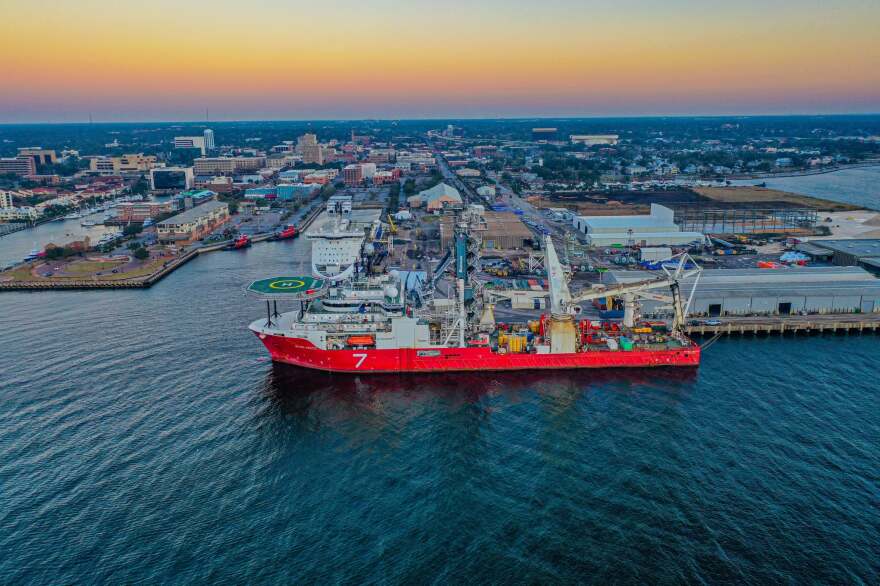Pensacola has applied for $15 million from Triumph Gulf Coast to build a rail‑served inland port and industrial park, a move Mayor D.C. Reeves says would relieve pressure on the city’s small downtown seaport and create room for growth on and off the waterfront.
Support Local Stories. Support Public Media.
The pre‑application, filed under the title “Pensacola Industrial Park and Inland Port: Beggs Lane Site,” outlines a 58‑acre project focused on a warehouse and site work — internal roads and stormwater — with a separate $4 million state port grant identified for a new rail spur. The city proposes to own the site and lease space to port‑related manufacturers and suppliers, beginning with Blue Wind Technology, a component maker tied to GE Vernova. The filing estimates 36 months for design and construction after funding, and projects roughly 334 jobs as tenants scale.
Reeves put the case in simple terms during his weekly news conference last week: the downtown Port of Pensacola sits on about 55 acres — unusually tight for a deep‑water port — and long‑dwell storage uses are eating up scarce waterfront space.
“What we all know about the characteristics of the Port of Pensacola is its prime location is a huge benefit in some ways, and its only 50‑ish acres can be a hindrance in some ways,” he said. The inland site, he argued, would “catalyze” growth at the waterfront and offsite.
“The potential of an inland port only catalyzes our potential growth at both the port facility and the inland port,” Reeves said.
Why an inland port?
An inland port is not a second harbor; it’s a rail‑connected logistics and industrial site that provides laydown yards, warehousing, and related space for companies that use the seaport. By shifting storage and some value‑add work off the waterfront, the city says it can free limited berths and pads downtown for higher‑value maritime activity.
Reeves cited GE’s wind‑turbine components to illustrate the current squeeze.
“GE is driving nacelles down, and so people see the nacelles on port and they assume they came in from boat,” he said. “Really, it’s storage area ... But that storage could take place on this finite 50 acres, or it could also take place somewhere with a rail spur ... We’re kind of at capacity from a storage standpoint right now.”
The city’s inland port filing underscores GE and its supply chain as the demand driver. A recent federal Foreign‑Trade Zones report shows how central that activity has become: the Pensacola‑area FTZ logged between $500 million and $750 million in merchandise received in 2023 — nearly all of it attributed to GE Renewables’ local operation — while other local warehouse/distribution activity amounted to a fraction of that total. City officials say adding rail‑served, off‑water capacity would support GE’s growth and its suppliers while clearing room on the waterfront for other uses.
What changes on the waterfront
City leaders have spent the past few years nudging the port toward a more mixed‑use, innovation‑oriented footprint. American Magic, the high‑performance sailing team, has committed to basing operations at the port, and the University of West Florida’s WAVE program — Watercraft and Vessel Engineering — is setting up there as well. Public‑facing activation, such as Portside Pickle’s courts and events, signals a shift away from the heaviest industrial uses at the water’s edge.
Reeves said the inland concept is designed to complement that direction rather than replace the working port.
“The inland port doesn’t have to just be for storage, asphalt, and a transfer,” he said. “There can be businesses that are built at that inland port as well.” He also cautioned against overpromising what a small, downtown‑adjacent port can be.
“We can’t snap our fingers and be the port of Savannah tomorrow and be a cargo container … that is the challenge,” he said. “But we’re trying to address that challenge by increasing our overall capacity in the port operation.”
Supporters and skeptics
Downtown developers and some residents have long argued that heavy storage and truck traffic at the waterfront depresses redevelopment potential and quality of life. A vocal port constituency counters that Pensacola’s maritime heritage and blue‑collar jobs depend on keeping an operational port in the city center. The inland‑port plan appears to offer a middle path: keep industry and manufacturing jobs in the region while curating the waterfront for maritime technology, research, and training.
Reeves framed the payoff in practical terms.
“When people call us at the port, we can say yes more often because we’ve got a little more land and a little more leverage to be able to do things,” he said. “If your bowl is this big and now it’s this big, it just opens up more opportunity for us to do things at both places.”
The policy backdrop
The city’s filing also nods to a shifting national context. Federal policymakers are pushing to rebuild domestic maritime and industrial capacity through executive actions and legislation such as the proposed SHIPS for America Act. If those efforts accelerate U.S. shipbuilding and related supply chains, Pensacola officials argue, having storage and manufacturing space inland — and room at the waterfront for maritime technology and training — would leave the region better positioned to compete.
What’s next
The Triumph Gulf Coast submission is a pre‑application; a full application and board consideration would follow if the project advances. Locally, the city would likely need to finalize land control, secure the state rail‑spur grant, and bring lease terms for prospective tenants to the City Council. Reeves said the goal is capacity — not a change in mission.
“We’re not hindered at this moment,” he said of current port business. “We anticipate that it will be … and that we’re trying to be out in front of that.”


